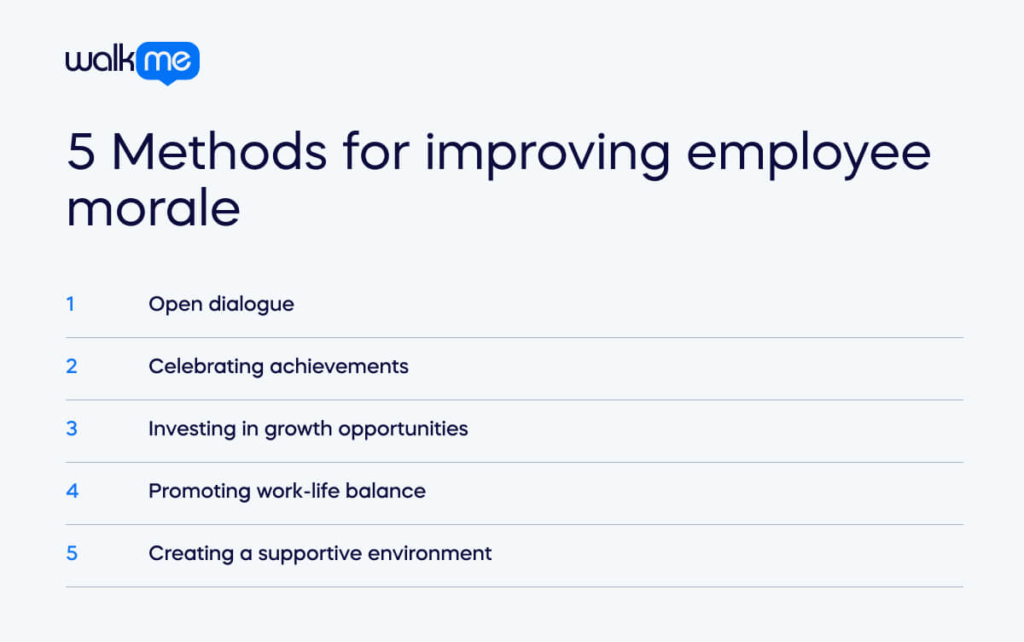What’s the key to sustaining a motivated workforce that consistently produces high-quality work? Well, it requires a particular focus on one overlooked factor—employee morale.
Employee morale is all about enhancing the employee experience. This means creating working environments wherein employees feel valued and empowered.
However, opting for a one-size-fits-all approach to improving employee morale isn’t recommended. These blanket solutions fail to recognize that what motivates one person might not work for another.
Recognizing the diversity in employee needs, preferences, and work styles is essential. Doing so creates a truly inclusive and effective strategy for enhancing organizational morale. Increased employee morale can lead to a more engaged, productive, and motivated workforce.
This article will explore employee morale, its importance, and methods for measuring it. We’ll also share tips on improving employee morale. Helping readers uncover why creating workplaces where employees can thrive is so important.
What is employee morale?
Employee morale is all about how employees feel about their work. It includes their overall thoughts, opinions, and happiness with their roles and responsibilities. Morale also covers their feelings about the work environment and the company sentiment as a whole.
High morale among employees is crucial for nurturing a positive and productive work culture. Employees who feel valued, supported, and engaged are more likely to be motivated. This creates environments where employees can innovate and better hit organizational goals.
High morale can also lead to lower turnover rates, reduced absenteeism, and increased job satisfaction. Therefore, organizations must prioritize initiatives to uplift employee morale. This creates a thriving and cohesive workplace environment where progress can thrive.
Why is employee morale important?

More than 4.3 million people voluntarily quitting their jobs in December 2021 in part of what was dubbed “The Great Resignation.” Organizational leaders have since been scrambling to find solutions for addressing this. This includes finding ways to attract new talent, train employees, and create workplaces that people love.
A reported 600 employees surveyed by McKinsey left a job voluntarily without securing another. Research shows that 76 percent eventually returned to traditional employment. They said the most important reasons to come back to work were flexible schedules, good pay, and fair expectations about their work.
Organizations now understand that simply hiring more people as a way to boost productivity can backfire. They’re learning it’s more about quality than quantity. Employee morale is the key to building a workforce that feels empowered, engaged, and motivated to produce their best work.
Boosting employee morale should seek to improve the overall employee experience. This means establishing work environments where employees feel both valued and empowered.
This reduces the risk of imposing expectations on employees to constantly produce results. Doing so enables organizations to unlock a more effective and sustained method for achieving said results.
5 Methods for improving employee morale

Companies benefit from higher employee engagement by creating a positive work environment. This directly contributes to increased productivity and overall organizational prosperity.
Let’s explore some practical methods to improve employee morale:
- Open dialogue
Managers and employees should be able to talk openly. This builds trust and helps them work together. Have regular meetings and give employees a chance to share feedback. This shows you value their ideas.
- Celebrating achievements
Celebrate employee wins. This encourages good work and makes employees feel valued. Start a formal recognition program or simply have employees praise each other. This will boost employee pride and motivation.
- Investing in growth opportunities
Help employees learn and grow in their careers. This shows you care about their success. Offer mentors, training, and clear paths for promotion. This gives employees the power to succeed within the company.
- Promoting work-life balance
Help employees balance their work and personal lives. This makes them happier and healthier. Offer flexible work options and wellness programs. Respect employees’ time away from work. This creates a better workforce.
- Creating a supportive environment
A workplace should be respectful, inclusive, and collaborative. This makes employees feel like they belong. Team-building, diversity, and support all show employees they matter. This motivates them to do their best.
How to measure employee morale
Recognizing the importance of measuring employee morale as a key indicator of organizational health is essential.
Businesses can improve workplace satisfaction and productivity by following the following steps:
- Employee satisfaction surveys
Objective: Gather comprehensive feedback on various aspects of the workplace environment to identify areas for improvement and gauge overall morale.
Action: Implement anonymous surveys to encourage honest feedback on job satisfaction, work-life balance, organizational culture, and management effectiveness. Analyze survey results and develop strategies to address identified issues.
- Turnover rate tracking
Objective: Monitor turnover rates to assess retention levels and identify potential morale issues.
Action: Track why employees leave. Look at their department, how long they worked for you, and why they gave for leaving. Analyze this information to find problems. Then, changes should be made to keep employees. This includes things like offering career development or improving work-life balance.
- Absence and tardiness monitoring
Objective: Assess employee engagement and overall job satisfaction by tracking absenteeism and tardiness rates.
Action: Maintain records of employee attendance and punctuality. Analyze patterns and correlations with metrics such as workload or job satisfaction survey results. Implement policies and initiatives to address underlying causes of absenteeism or tardiness.
- Peer recognition program
Objective: Foster a culture of appreciation and acknowledgment to boost morale and motivation.
Action: Let employees nominate coworkers who are doing a great job! Publicly recognize and reward those employees. Give shoutouts throughout the company or hold an awards ceremony.
5. One-on-one meetings
Objective: Provide opportunities for open communication between managers and employees to address concerns and build rapport.
Action: Managers should have regular one-on-one meetings with their employees. They can talk about job performance, career goals, and any problems. Managers should listen closely, offer helpful feedback, and support their employees.
6. Training and development opportunities
Objective: Promote skill growth and career advancement to enhance job satisfaction and morale.
Action: Offer various training and development programs tailored to employees’ interests and career goals. Provide opportunities for cross-training, mentorship, and participation in workshops or conferences. Encourage employees to pursue certifications or further education relevant to their roles.
7. Employee engagement surveys
Objective: Measure levels of enthusiasm and commitment to the organization’s goals.
Action: Conduct periodic pulse surveys or feedback mechanisms to gauge employee engagement. Use survey results to identify areas of strength and opportunities for improvement. Implement initiatives to enhance engagement. These can be team-building activities, recognition programs, or communication workshops.
8. Company culture assessment
Objective: Evaluate employee perception of company culture and values.
Action: Facilitate focus groups or anonymous feedback channels to gather insights into employees’ perspectives. This helps with company culture, values, and workplace norms. Analyze feedback to identify alignment or gaps between desired and actual culture. Develop strategies to reinforce positive aspects of the culture. But, don’t forget to address areas needing improvement.
9. Performance metrics analysis
Objective: Identify potential correlations between performance metrics and morale levels.
Action: Look at how well employees are doing their jobs. Are they productive? Do they do quality work? Are customers happy? See how these things relate to employee morale. Then, figure out what impacts employee morale and performance. It could be things like workload, happiness with their job, or boss. Use this information to make targeted changes that will improve both morale and performance.
10. Exit interviews
Objective: Gather insights into the reasons for employee departures and identify underlying morale issues.
Action: Talk to employees who are leaving to find out why. Were they unhappy with their job? Did they see a future for themselves in the company? Were they having problems with coworkers or their boss? Look for patterns in their answers. Use this information to make changes that keep employees happy and motivated.
What are the advantages of high employee morale?
Companies need to understand that happy employees are good for business. Employees who feel good about their jobs work harder, stay with the company longer, and help the business succeed.
Research from Haiilo indicates that employee engagement positively impacts workplace productivity. It shows that actively engaged employees surpass their less engaged counterparts.
Generally, companies with high levels of employee engagement experience a 21% increase in profitability.
Besides a motivated and productive workforce, there are other advantages to uplifting employee morale. These include:
Enhanced innovation
A positive work environment encourages employees to think creatively and contribute innovative ideas. When employees feel good about their work, they’re more likely to share ideas and work together. This leads to amazing new products and helps the company stay ahead of the competition.
Reduced turnover
High morale fosters loyalty and reduces employee turnover rates. Employees who feel appreciated, supported, and happy with their workplace are much less likely to look for new jobs. This saves companies money hiring new people, training them, and the drop in productivity when employees leave.
Improved customer satisfaction
Happy employees provide better customer service. They are more invested in their work and eager to help customers. This leads to happier customers, increased loyalty, and positive recommendations for the business.
Stronger team cohesion
A positive workplace with high morale helps employees feel connected to their team. Employees who feel respected and supported by their team work better together. They openly share ideas and solve problems without conflict. This creates a strong, successful team and helps the entire company thrive.
Enhanced brand reputation
When a company treats its employees well, it attracts the best people and builds a strong reputation. Happy employees tell others about their great workplace. This can make the company look appealing to potential new hires. It also helps the business find and keep the most talented people, even when there’s a lot of competition.
Increased resilience in times of change
High morale gives employees the strength and flexibility to handle tough situations and changes. Employees who feel supported and valued are more willing to try new things and overcome challenges. They work together better to reach common goals. This helps the whole company succeed, even when things are unpredictable.
Greater employee engagement
When employees feel good about their work, they care more and work harder. Employees who feel motivated, valued, and connected to the company’s goals will naturally put more effort into their jobs.
Positive impact on the bottom line
Boosting employee morale has a direct, positive impact on a company’s success. Businesses see higher productivity, more innovation, lower employee turnover costs, and happier customers. Investing in employee happiness brings clear financial benefits and helps companies achieve long-term success.
What factors affect employee morale?
Every employee is different. This makes it hard to find one solution that boosts morale for everyone in the company. A better approach is to use several strategies to improve the attitudes and performance of your diverse workforce.
However, some prominent factors affect employee morale within the modern workforce. These involve:
Communication
Open, transparent communication channels create trust and alignment within the organization. A Forbes Advisor survey shows that 45% of workers feel bad communication hurts trust. This makes them lose confidence in their leaders and teammates. Employees want to know about company updates, goals, and expectations. They also want the chance to share their ideas and concerns.
Feedback and recognition
Regular feedback and acknowledgment of contributions are crucial for boosting morale. Employees thrive when their efforts are recognized and appreciated. It keeps them going and motivates them to strive for excellence.
Growth and development opportunities
Employees want to learn and grow in their careers. Companies that offer training, mentors, and clear ways to advance tend to have happier employees.
Promotions and benefits
When promotions are fair and clear, and employees get good benefits, it shows the company values its employees. This helps keep employees loyal. Perceived fairness in promotions and benefits can significantly impact employee morale.
Flexibility
Employees value the ability to balance work commitments with personal obligations. Flexible work options, like working from home or choosing your hours, make work better for employees. Atlassian’s research shows this improves innovation, well-being, and employees’ views of the company. It also helps prevent burnout. 55% of surveyed employees can choose between home and office daily, with 51% having the freedom to live elsewhere.
Job security (or lack thereof)
Uncertainty about job stability can have a significant impact on employee morale. Companies should be honest with employees about finances and job security. This helps employees feel less worried and keeps morale high, even during hard times.
Strong leadership
Effective leadership sets the tone for the organization and influences employee morale. Employees trust leaders who are honest, caring, and have a plan for the future. This trust boosts morale and gets employees more involved in their work.
Gallup estimates that managers have a huge impact on employee engagement. In fact, 70% of the difference in engagement levels across a company is due to the managers. This variation is a major factor behind the low levels of employee engagement seen worldwide.
Colleague and manager relationships
Employees’ getting along with their coworkers and bosses makes work more enjoyable. People are more likely to help each other and work together as a team. Healthy interpersonal dynamics, built on respect, trust, and teamwork, foster a sense of belonging and boost morale.
Achieving a work-life balance
Employees need time for work and for their personal lives. This keeps them happy and healthy. Companies that support work-life balance have better employees. Their employees are happier, more productive, and more likely to stay with the company.
Organizational reputation
The reputation of the organization, both internally and externally, can impact employee morale. When a company does business ethically, supports its employees, and helps the community, employees feel proud. This makes them more loyal to the company.
Uplifting employee morale for the modern workforce
Businesses industry-wide are currently experiencing a digital transformation. This requires agility, innovation, and the ability to change quickly. However, increased digital adoption is only as effective as the employees driving these transformations.
Companies are scrambling to find skilled workers, with this “war for talent” showing no signs of slowing. A recent Korn Ferry study forecasts a global human talent shortage of more than 85 million people by 2030. Left unchecked, this could result in about $8.5 trillion in unrealized annual revenues.
Employee morale is essential for a successful business. It helps companies keep talented workers and fuels innovation. High turnover disrupts progress. According to a TriNet study involving over 600 U.S. businesses with 50-500 employees, 63.3% of companies say keeping employees is tougher than hiring new ones.
Building strong employee morale isn’t just about numbers; it’s about people. It’s about leveraging the potential of your workforce. Our advice for team leaders? Create a workplace where individuals thrive, innovation flourishes, and long-term growth becomes a natural outcome.


